|
Report
from
North America
US tropical timber imports
Hardwood sawnwood imports down in August
The decline in imports of sawn tropical hardwood continued this summer.
The US imported 17,382 cu.m of tropical sawnwood in August 2010, 8% less
than in July. The following species recorded increases over July: acajou
d¡¯Afrique (2,801 cu.m or +33%), keruing (786 cu.m or +74%), cedro (639
cu.m or +41%), jatoba (661 cu.m or +24%), teak (342 cu.m or +48%) and
padauk (61 cu.m or 33%). The largest declines were seen in virola (369
cu.m or -72%) and mahogany (871 cu.m or -56%).
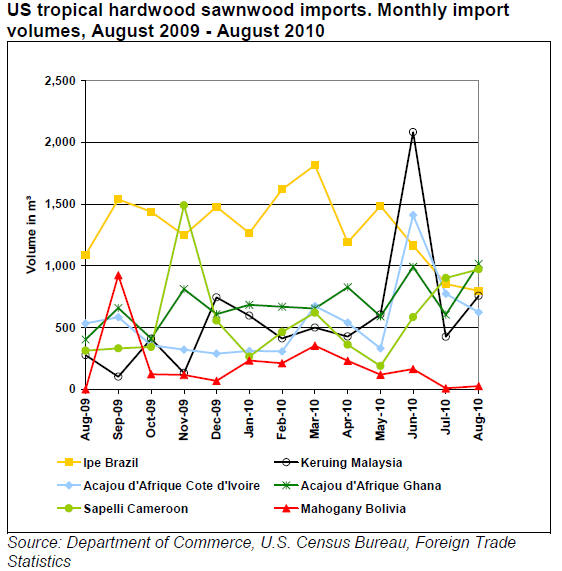
Ecuador remained the leading source of tropical sawnwood with 5,392 cu.m
imported in August, followed by Cameroon (2,063 cu.m) and Brazil (1,921
cu.m). Imports from Peru dropped by 80% to just 284 cu.m from 1,444
cubic metres in July.

Year-to-date tropical sawnwood import volumes were 8% higher in August
than in the same period last year. Among the species with the largest
gains are acajou d¡¯Afrique (+69%), keruing (+26%), red meranti (+31%)
and jatoba (+106%). The year-to-date value of tropical sawnwood imports
was 16% higher than in July 2009.
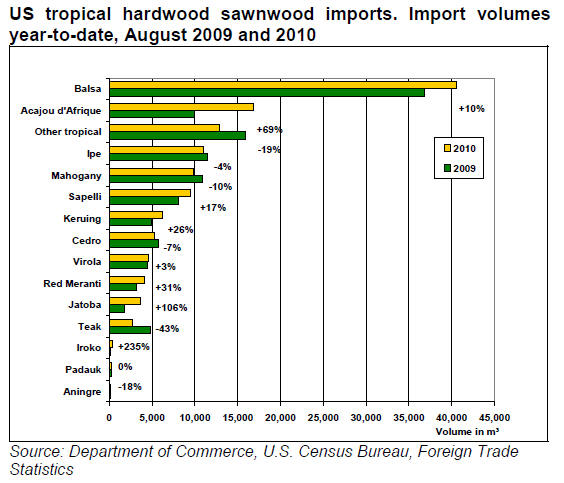
Hardwood plywood imports soar
US imports of hardwood plywood increased again in August 2010, mainly
because imports from Indonesia soared. Year-to-date imports were
US$853.3 million, up by 40% from the same period in 2009. Monthly
imports were worth US$142.5 million in August, up 11% from July. August
2010 imports from China were US$78.6 million (+34% year-to-date),
Indonesia US$22.9 million (+108% year-to-date), Malaysia US$11.2 million
(+325% year-to-date), Brazil US$1.7 million (+4% year-to-date) and
Ecuador US$2.7 million (+54% year-to-date).
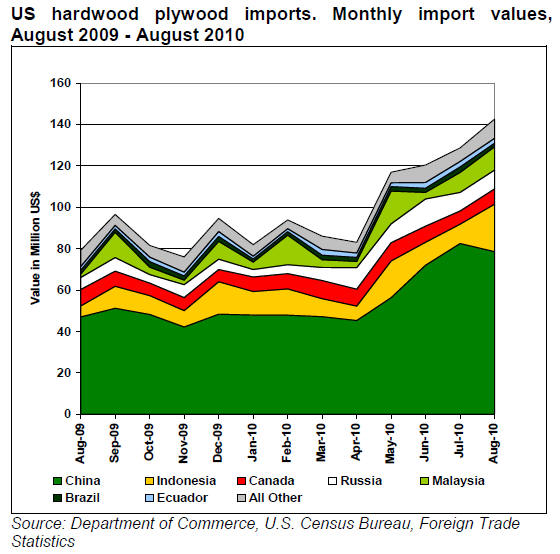
Hardwood moulding imports slip in August
US hardwood moulding imports were US$17.1 million in August, a decline
of 11% from the previous month. Year-to-date imports were US$123.9
million in August, up by 5% compared with the same period last year. The
largest year-to-date increase was in imports of cumaru mouldings (+39%),
while imports of mahogany, ipe and jatoba moulding declined compared to
the same period in 2009.
The US imported from Brazil US$2.1 million worth of jatoba moulding in
August (-11% from July), US$490,000 of ipe moulding (-9%) and US$332,000
of cumaru moulding (+4%). The value of cumaru moulding imports from Peru
continued increasing (US$539,000 or +6% from July).
China is the US¡¯ leading supplier of mouldings (US$41.5 million
year-to-date), followed by Brazil (US$34.8 million year-to-date).
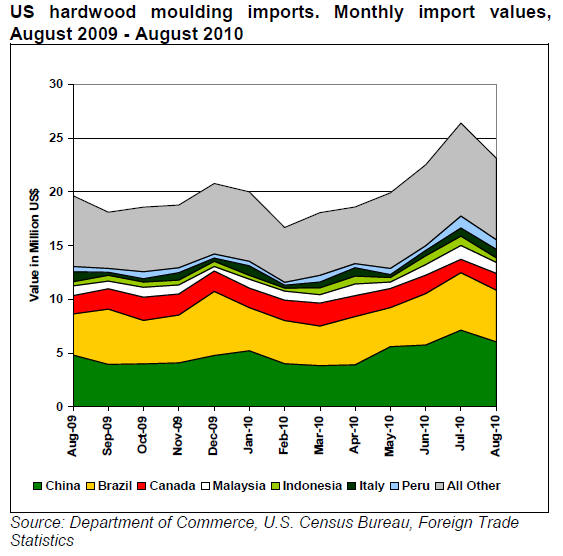
Hardwood flooring imports plunge
Hardwood flooring imports declined again in August after briefly
climbing in June and July of this year. Total August imports were valued
at just US$1.2 million, a 34% drop compared to July. Year-to-date
imports declined by 46% compared to August 2009. China is the country
most affected by this decline. August imports from China were just
US$296,000, a 69% drop compared to year-to-date August 2009. Of the top
suppliers, only Canada saw an increase in exports to the US. Of the
smaller hardwood flooring suppliers, Indonesia and Bolivia have been
able to increase exports this year (+14% and +22% year-to-date,
respectively). Hardwood flooring imports from Brazil were US$137,000 in
August (-9% year-to-date). Malaysia¡¯s exports were US$140,000 (-17%
year-to-date).
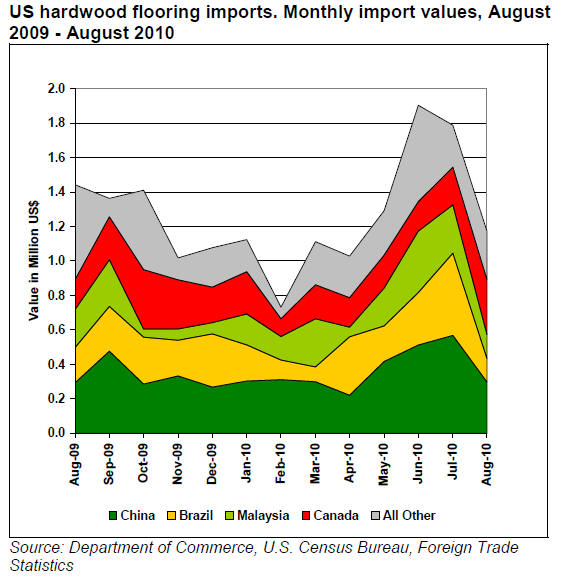
UNECE Timber Committee issues market statement and forecasts for US and
Canada
The United Nations Economic Commission for Europe (UNECE) Timber
Committee delegates met for their annual market discussions in Geneva on
11-12 October 2010. The US market review and outlook to 2011 was again
written by James Howard and David McKeever, both with the Forest
Products Laboratory in Madison, Wisconsin, while the Canadian Forest
Service prepared the market statement for Canada.
Residential construction is the single largest driver of wood products
demand in the US and Canada. Since the US housing crash in 2008 and
2009, the housing sector has not recovered and home construction is
forecast to remain weak throughout 2010. GDP growth has also been lower
than expected in 2010, and demand for wood products is unlikely to
recover before the second half of 2011.
Demand for sawn hardwoods is weak in North America, and US producers are
seeking to expand offshore markets. US sawn hardwood production
decreased by 28.6% to 16.5 million cu.m in 2009. Production is expected
to drop further to 15.5 million cu.m in 2010 and remain below 16 million
cu.m in 2011. US exports of sawn hardwood are forecast to increase from
1.7 million cu.m in 2010 to 1.9 million cu.m in 2011. Given the decrease
in US production, volatile trade figures, and a declining housing
market, apparent consumption of sawn hardwood for 2010 is forecast to
fall below the 2009 volume (15.2 million cu.m) and increase slightly in
2011.
Tropical hardwood sawnwood consumption in North America (excluding
Mexico) is forecast to increase by 17% in 2010 and 29% in 2011 compared
with 2009 volumes. The projected growth will be in Canada, while
consumption in the US is expected to remain stable at 177,000 cu.m (2009
to 2011). For Canada, consumption of sawn tropical hardwood is expected
to grow from 34,000 cu.m in 2009 to 70,000 cu.m in 2010 and to 95,000
cu.m in 2011. While the Canadian economy is closely linked to the US
economy, the Canadian housing market, non-residential construction and
the renovation market have been less affected by the recession and are
recovering more quickly.
The full country market statements for the US, Canada, Europe and Russia
are available on the UNECE Timber Committee website: timber.unece.org
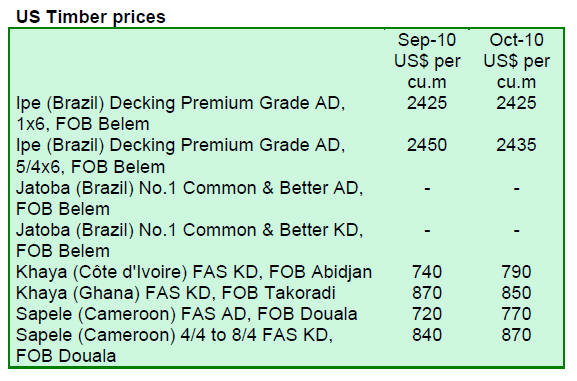
Related News:
|